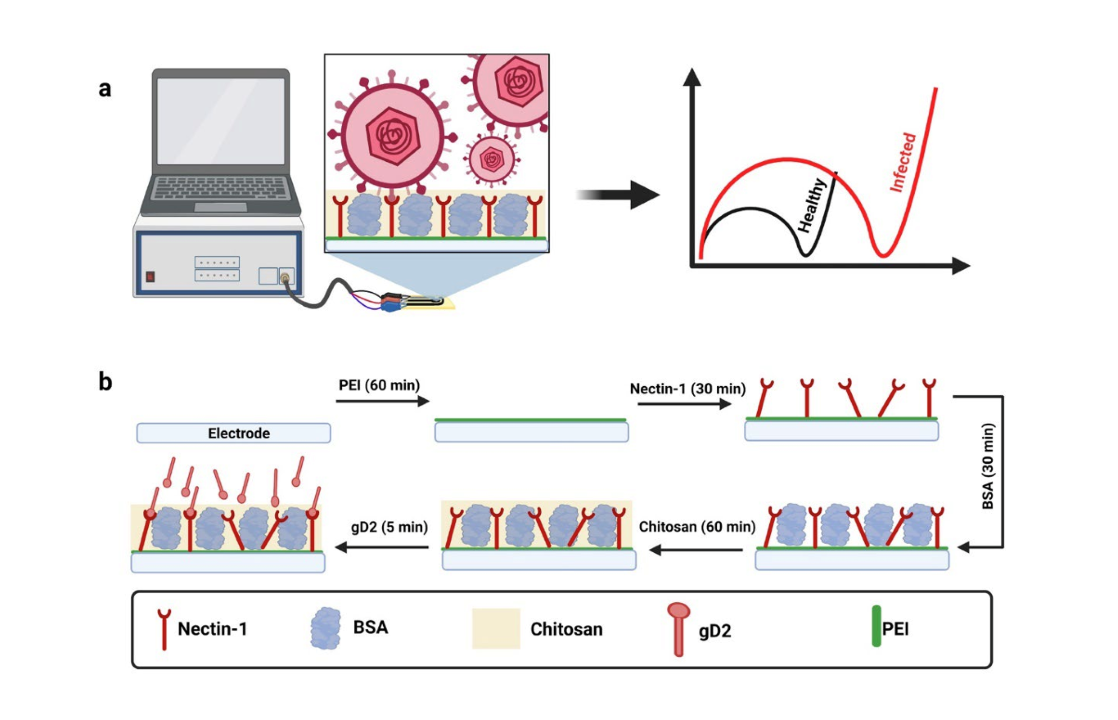A low-cost electrochemical biosensor for rapid and accurate detection of Herpes Simplex Virus-2 (HSV-2) that employs a cell receptor-coated electrode surface to detect HSV-2 glycoprotein binding events.
Problem:
Herpes Simplex Virus-2 (HSV-2) is a common sexually transmitted disease that impacts a significant amount of the global population, affecting around 13.2% of people aged 15-49, or almost five hundred million people. Despite its prevalence, there is a lack of rapid, affordable, and accessible HSV-2 detection tests. Current tests rely on viral nucleic acid detection and display varying levels of accuracy. Serological tests like ELISA rely on the presence of HSV antibodies, making their sensitivity dependent on the time since infection. Moreover, these tests are time-consuming, expensive, labor-intensive, and require highly trained personnel and specialized laboratory facilities.
Solution:
An electrochemical device that accurately detects HSV-2 antigens within 9 minutes of administration can be manufactured at the low cost of $1. Additionally, this method avoids issues inherent to other HSV-2 detection tests, like PCR-based methods that are prone to incorrect base-pairing. Furthermore, the biosensor shows adequate sensitivity, 100% selectivity for HSV-2 over other viruses, and 95% accuracy in detecting HSV-2 in pre-clinical animal models.
Technology:
Upon HSV-2 attachment to the host cell surface, an HSV-2 molecule, glycoprotein D (gD2), binds to receptors on the host cell. This binding triggers a series of events that lead to the HSV-2 fusion with the host cell's plasma membrane, and thus infection. This invention leverages the specific binding between human cell receptor nectin-1, immobilized on an electrode surface, and gD2. If gD2 is present in a bio sample and applied to the immobilized nectin-1 electrode surface, the biosensor will detect the change in electron transfer process and will indicate a positive result.
Advantages:
- Can fabricate at the lost-cost of $1, which can be especially useful for HSV-2 detection in low-resource settings
- Acquire rapid results that takes only 9 minutes from time of administration
- Uses antigen detection over nucleic acid detection, thus avoiding issues with base-pairing mismatches and hybridization problems
- Electrochemical devices may lend themselves to increased portability and accessibility

Schematic describing (a) representative workflow and expected results of the electrochemical biosensor used for HSV-2 antigen detection; and, (b) the optimization and functionalization steps of the working electrode surface with immobilized nectin-1.
Stage of Development:
- Proof of Concept
- Bench Prototype
Intellectual Property:
- Provisional Application No. 18/296,613
Reference Media:
- Torres, M. D. T. et al., Matter., 2021 Jul 7; 4(7): 2403
- Cairns, T. M. et al., J. Virol., 2020 Sep 29; 94(20): e00983
- Giovine, P. Di et al., PLoS Pathog., 2011 Sep;7(9):e1002277
- de Lima, L. et al., Sci. Direct, 23 August 2023: 101513
Case ID:
23-10377-tpNCS
Web Published:
6/23/2023
Patent Information:
| App Type |
Country |
Serial No. |
Patent No. |
File Date |
Issued Date |
Expire Date |